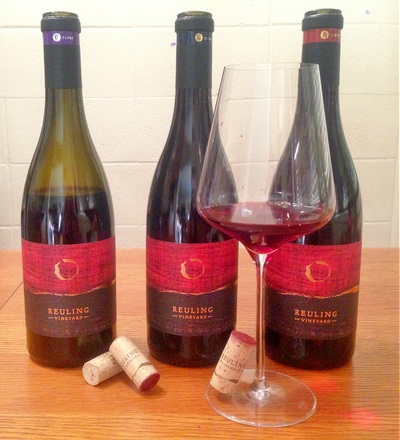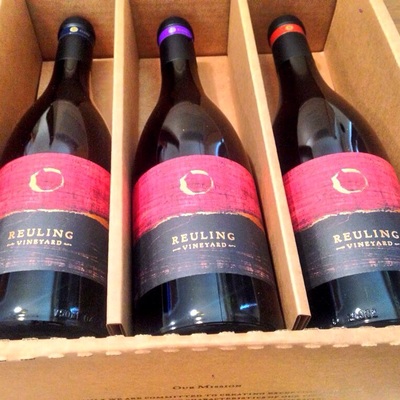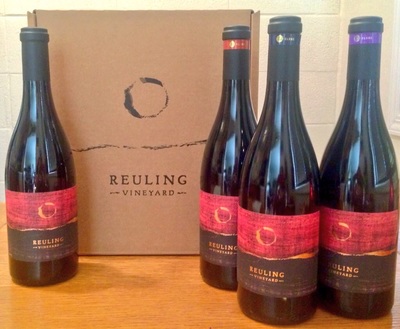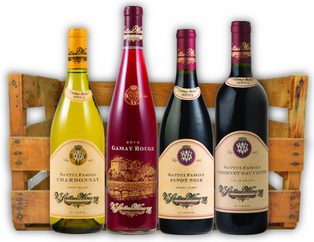 Thanksgiving is all about family and food, and there is no better way to embody that spirit at the Thanksgiving dinner table than to invite a lovely collection of wines from one Napa Valley’s most loved families—the Sattui family. V. Sattui Winery, located in the southern reaches of the gorgeous St. Helena appellation, has put together a special collection of wines for the Thanksgiving dinner table this year. All chosen to pair perfectly with an array of Thanksgiving main courses and side dishes, the collection features four fantastic varietals: Gamay Rouge, Chardonnay, Pinot Noir and Cabernet Sauvignon. These wines are classic choices for Thanksgiving—lending themselves well to the array of delicious food and enhancing the textures, flavors and experience of each bite. What’s more is that enjoying great wine also brings family together—creating that warmth of spirit, stimulating endless conversation, and providing an overwhelming sense of gratitude for love and family. V. Sattui Winery’s Thanksgiving Box offers every member of the family an enjoyable Thanksgiving wine experience. With four distinct wines, there is something to strike the fancy for each individual palate. The 2014 Gamay Rouge, a newly-released Rosé-style wine made of the French Gamay grape variety, is excellently suited to the turkey, cranberry sauce and natural sweetness of the sweet potatoes. With an aromatic nose and sensuous palate full of red fruit flavors of strawberry, cranberry and maraschino cherry, this wine is a great way to begin the meal. Furthermore, the notes of apple blossom and gentle sweetness are a heavenly combination. Drink this at the dinner table or even before dinner while you are cooking it up in the kitchen! Another classic Thanksgiving wine is Chardonnay, and the new 2014 Sattui Family Chardonnay release certainly does not disappoint. Lovely aromas of citrus fruit coupled with crisp green apples and a touch of vanilla embody the spirit of the season; the palate brings a rich mouthfeel juxtaposed against nice acidity, with alluring flavors of apple and deliciously-spiced butter. This is both delicate and rich—simply delicious with turkey drenched in gravy and butter-laden mashed potatoes. Pinot Noir is perhaps the wine most commonly paired with Thanksgiving dinner, and for good reason! Pinot Noir is delicate and flavorful, as well as textured and flexible with a range of flavors. The newly-released 2013 Sattui Family Pinot Noir is masterful at complementing the flavors of the Thanksgiving dinner table. Lending itself well to the succulent turkey, you could choose to dip bites into cranberry sauce that would highlight the fruit flavors of the Pinot, or even dip bites into gravy to enhance the texture and richness of the Pinot—yielding two very different, but equally delicious pairing combinations. Pinot Noir can even be enjoyed with those vegetable side dishes! Take for instance a classic green bean casserole. The wine is full of fruit and earthy flavors, the latter of which marries quite well with the rustic flavor of green beans. For those looking for a little more gusto in terms of body and richness with their Thanksgiving wine pairing, look no further than the 2011 Sattui Family Cabernet Sauvignon. This wine is a classic Napa Valley Cab that is approachable in its youth and offers a bit more weight for the serious, robust red wine drinkers at your Thanksgiving table. You may be thinking that Cabernet Sauvignon is a bit too heavy for turkey, but its ability to pair with Thanksgiving foods all depends on the style of the wine. This particular Cabernet Sauvignon is crafted to be enjoyed young—the tannins are gentle, the fruit is juicy and up front on the palate, and the balance between fruit and earth make this wine versatile for pairing. Savory flavors of earth, ginger and cocoa mingle with floral touches of lilac and red and black fruit, all wrapped up in a sophisticated style. Robust enough to handle gravy and stuffing, but gentle enough to bring a little oomph to the turkey, this Cabernet Sauvignon is a welcomed addition to any Thanksgiving dinner. For Thanksgiving this year, invite the Sattui family to your family dinner table with their stunning Thanksgiving Box collection. *Originally published on Examiner.
0 Comments
Burgundian-Style, California Pinot Noir
Pinot Noir is quite literally on the tips of everyone’s tongues these days—both as people enjoy the wine and as people continue to talk about it. It’s an interesting varietal that can be interpreted in many ways—depending on vineyard practices and winemaking techniques—and as wine lovers learn more and challenge themselves to expand their palates, varying styles of Pinot Noir are being sought after by just about everyone. One thing is for certain: the demand for high quality Pinot Noir is on the rise—and winemakers are responding in kind. Case in point--Reuling Vineyard, located on a 16-acre property just outside of Forestville in Sonoma County, has splashed onto the Pinot Noir scene with their Burgundian-style expressions. The boutique-size, family-owned winery focuses production strictly on Pinot Noir and Chardonnay, and many of the clones they work with are Burgundian—making their wines taste delightfully similar to wines from Burgundy. In fact, of much of the Sonoma County Pinot Noir I have tasted, ReulingVineyard’s newly-released 2013 Pinot Noirs tastes more like French Red Burgundy than just about anything else on the local market. The Pinot Noir Clonal Collection Ever since the family purchased their property in 1998, and planted their vines in 2000, they have been caring for the vineyards in a sustainable and biodynamic environment. In 2010 they produced their first vintage, and this year, they just released their third vintage with the new releases. With the immense quality of the 2013 vintage, Winemaker Matt Taylor decided to do something different with the wines. For the first time ever, Reuling Vineyard released their Pinot Noir Clonal Collection—a unique selection of wines that showcase the individual characteristics of three distinct clones, as well as one blend that brings together each of the clones. The family “focused on wanting to make the wine in a Burgundian style with clones that would match that interest,” Marika Reuling states. Hence why two illustrious “suitcase” Vosne-Romanée clones were chosen, as well as the renowned Calera clone. (It’s worth noting that they also work with an exquisite Montrachet Chardonnay clone.) To say that the family has chosen their clones wisely is an understatement; they have clearly honored their Burgundian-style winemaking passion by choosing to work with these particular clones. The 2013 Vintage 2013 birthed incredible fruit and in Taylor’s eyes, possessed the perfect quality to showcase and introduce their Pinot Noir Clonal Collection. Taylor truly “felt that each individual clone was really singing, and doing something special during that harvest,” Reuling says. “It’s been fascinating to see watch Taylor do something different with these grapes.” Something different, indeed. Taylor has produced California Pinot Noir from the Sonoma Coast appellation that really does taste like Burgundy, and in that regard, he has also carved out a unique space where locals can experience a different style of Sonoma Cost Pinot Noir. In these wines, their uniqueness shines brightly and Taylor transcends the bounds of expectations. Clearly drawing on a Burgundian style of winemaking, the wines showcase their terroir and natural characteristics; the inclusion of whole cluster fermentation with native yeast, as well as a small percentage of new oak used for aging, contributes to their Burgundian style and distinct qualities. Simply put, Reuling Vineyard’s 2013 Pinot Noir Clonal Collection is a taste of French red Burgundy from California’s Sonoma Coast. I have no doubt that Pinot Noir lovers will be jumping on the Clonal Collection in no time to store bottles away in their cellars. Reuling Vineyard Terroir Let’s talk terroir. Like all California Pinot Noir, Reuling Vineyard’s vines are endowed with a significant maritime influence; perched atop a knoll of sandy Goldridge soils at a western-facing exposure, the microclimate is ideal for Pinot Noir and Chardonnay. Due to its proximity to the coast, as well as its 250-feet elevation, there is a perfect balance between moderate, maritime temperatures and steady California sunshine. The vines produce naturally low yields and very concentrated grapes. Their sustainable and biodiverse practices in the vineyard also contribute to the quality of the wines. In recent years, the family has transitioned to cane pruning, which decreases the risk for trunk diseases and increases the meticulous attention that each vine receives. They also annually plant a range of cover crops post-harvest. A small herd of sheep are used to maintain the cover crops, and other significant wildlife populations contribute to the biodiversity of the vineyard’s ecosystem; the family maintains owl, bat and bee populations on the property. Another aspect of terroir that isn’t commonly talked about when it comes to New World wines, is the use of native yeast fermentation. It is more common for New World winemakers to use non-native yeasts during fermentation, while in France, the practice of strictly fermenting with native yeasts is more common (especially in Burgundy). To keep in line with their Burgundian-style ethics, Reuling Vineyard ferments these wines with strictly native yeasts, which certainly gives the wine more transparency and naturalness —allowing the wines to show off their clonal characteristics and terroir-specific qualities. Another practice that they employ, and one that is very important to the authenticity of their Burgundian-style wines, is whole cluster fermentation. Each of the three clones receives partial whole cluster fermentation (30% for the Calera “C” clone and “R” clone, and 60% for the “L” clone). This practice imparts characteristics in the resulting wines that are unique to each clone. In so many ways, Winemaker Matt Taylor has crafted a very natural expression of Pinot Noir in each of his clones, and the 2013 Pinot Noir Clonal Collection is a brilliant way to showcase these stunning and distinct offerings. 2013 Pinot Noir Clonal Collection Ruby red in color with a light ruby, almost fading-brick color on the rim, the 2013 Calera “C” Clone Pinot Noir boasts red cherry, strawberry and warm cranberries on the nose; additional aromas of a touch of grape stem and savory characteristics also linger in the background. The palate is silky and plush on entry, followed by a lot of spiciness on the mid-palate—tasting almost of white pepper. There is nice acid and tannin in this wine, balanced by its savory flavor of smoked meat, with under-ripe red cherries and cranberry. This is a spicy Pinot Noir, one that has a lot of energy and vivacity on the palate! The 2013 “L” Clone Pinot Noir has a darker color in the glass than the Calera “C” Clone; it shows a dark ruby core with an almost purple-like rim. The aromatics are driven by the native yeast fermentation with significantly darker fruit than the Calera “C” Clone. Aromas of blackberry, blueberry and dark chocolate hover above the glass in perfect balance. On the palate, this wine is full and round, also silky on entry, and the whole cluster fermentation is a touch more noticeable. There are earthy, soil-like characteristics on the palate of this wine that nicely balance the darker fruit flavors. Black cherry, dark raspberry and blueberry are enmeshed together in a zippy, energetic and lively mouthfeel. Finally, the wine finishes with a touch of that same spice found just a bit more plentifully in the Calera “C” Clone. The third Pinot Noir of the collection, the 2013 “R” Clone Pinot Noir, is lighter in color than the “L” Clone—more akin to the “C” Clone; it has a ruby/orange-like core with a brick-like rim. Clearly the earthiest in aromatics, the “R” Clone expresses wooded and soil scents followed by red fruit. After a few minutes in the glass, the earthiness on the nose fades a little, and more abundant notes of dark cherry and rose petals begin to leap from the glass. Silky and soft on the palate at first sip, then again leading into a very spicy mid-palate, the wine tastes of rose petals, wet rocks, cranberry and sour red cherry. The body of the “R” Clone feels slightly fuller than the Calera “C” and “L” clones, with just a touch more roundness. Reuling Vineyard’s new 2013 Pinot Noir Clonal Collection is truly incredible; these fine, Burgundian-style wines from California’s premier Sonoma Coast appellation may be small production—just 1,000 cases total for all four of their current release Pinot Noir bottlings—but the impact that these wines will have on wine lovers will be anything but small. I highly recommend seeking out these wines. 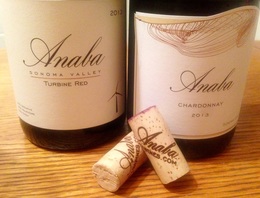 Tasting new releases is exciting; it gives me the opportunity to experience wines I may not be familiar with from certain producers, and allows the winery to really showcase their range and depth of varietals. This fall, Sonoma County’s Anaba Wines released a very well balanced Chardonnay and a tasty, young-drinking GSM blend called Turbine Red. Both of these wines are 2013s, with the Chardonnay’s fruit being grown in the Sonoma Coast appellation and the Turbine Red’s fruit being grown in the Sonoma Valley appellation. Committed to producing quaffable Sonoma County wines from Rhône and Burgundian grape varieties, winemakers Ross Cobb and Katy Wilson work closely with growers—whom they’ve formed long-term relationships with—to produce wines of excellent quality and character. Canopy management, cluster-thinning and sustainability in the vineyards are just a few of the quintessential practices that Anaba Wines adheres to. These practices are certainly admirable, and no doubt contribute to the finesse of the Anaba Wines new releases. 2013 Chardonnay, Sonoma Coast Coming from the Sonoma Coast appellation, the 2013 Chardonnay is comprised of three clones—Wente, Clone 95 and Clone 17—that are grown in several well-known vineyards: Dutton Ranch, Sangiacomo, Denmark Vineyard and Sullivan Vineyard. Once harvested, the grapes receive meticulous hand-sorting before whole cluster pressing and fermentation in barrels (60%) and stainless steel (40%); the grapes undergo 100% malolactic fermentation. The wine then sees nine months aging on lees in 35% new French oak barrels. This small production wine finishes at just 814 cases. The winemaking technique of the 2013 Chardonnay is very well balanced. The juxtaposition of barrel and stainless steel fermentation, followed by just about a third of new French oak used for aging, gives sophisticated poise to the texture and flavor. Malolactic fermentation imparts a richness, and the touch of new oak gives the wine extra body and gentle, oak-nuanced flavors, but this Chardonnay is never too buttery or over-the-top. The fruit still shines through very nicely, making for a pleasurable, well-rounded Chardonnay that is just lovely to sip on its own. I love the aromatics of this Chardonnay: pineapple, bruised yellow apple, honey, spiced apples and beeswax all emanate, once you give the chilled wine a bit of time to warm up in the glass. As I noted about the winemaking technique with this wine, the oak provides a backbone on the palate for the layers of fruit and spice that unfold. Bruised yellow apples, cinnamon apple, lemon meringue and a touch of caramel mingle together on the palate. Medium-bodied, round and full of life, this Chardonnay has a balanced energy about it that kept making me go back to the glass for another sip. Although I didn’t pair this with food, I could imagine it going particularly well with roasted chicken and vegetables—throw some diced green apples into those vegetables and you’d have a real tasty pairing! 2013 Turbine Red, Sonoma Valley The 2013 Turbine Red, a blend of 42% Grenache, 28% Syrah and 30% Mourvèdre, comes from two Sonoma Valley vineyards: Landa Vineyard and Bismark Vineyard. Each grape variety was harvested, fermented (without stems) and aged separately in an average of 30% new French oak, prior to blending the final wine. Classic Rhône aromas of meat and briney olives, along with roasted coffee beans, leap from the glass. Just released, the wine is youthful on the palate—I would suggest giving the wine about an hour of air before drinking, just to let it center itself. If you have patience, another three to six months in the bottle would allow the oak and fruit to really synergize. When drinking now, the wine is lovely and will be beautiful to drink in its youth and over the next couple of years. The medium body gives way to ample meaty notes and fruit flavors of blueberry and blackberry; additional notes of cocoa and oak nuances layer themselves on top of the fruit. This is a tasty wine with plenty to offer, especially for those looking for an easy drinking red that can be paired with a variety of foods. A classic French cassoulet would be an excellent match. |
Wine Blog Archives
December 2020
|
